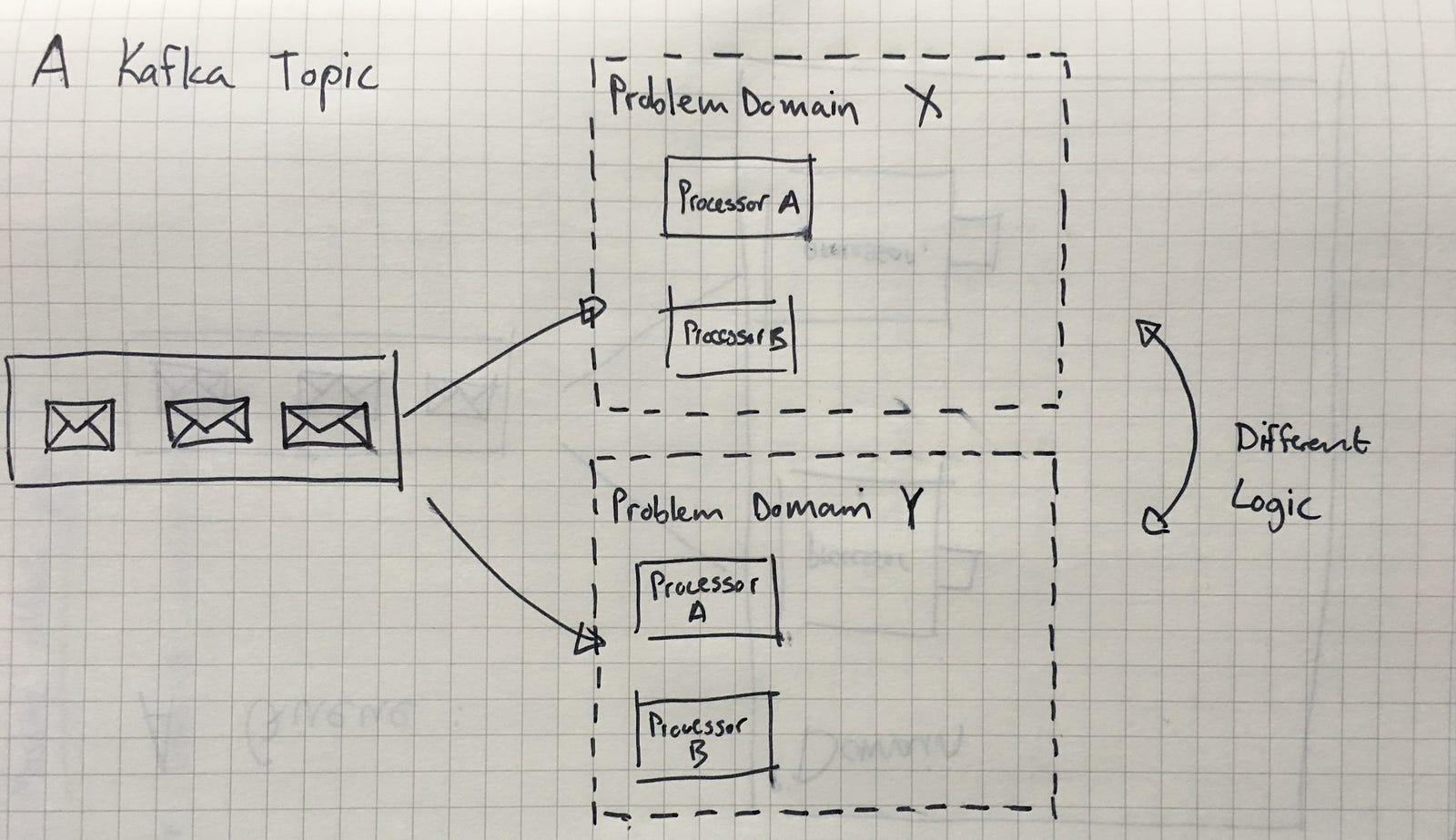快速比较 Kafka 与 Message Queue 的区别
https://hackernoon.com/a-super-quick-comparison-between-kafka-and-message-queues-e69742d855a8
A super quick comparison between Kafka and Message Queues

This article’s aim is to give you a very quick overview of how Kafka relates to queues, and why you would consider using it instead.
Kafka is a piece of technology originally developed by the folks at Linkedin. In a nutshell, it’s sort of like a message queueing system with a few twists that enable it to support pub/sub, scaling out over many servers, and replaying of messages.
These are all concerns when you want to adopt a reactive programming style over an imperative programming style.
The difference between imperative programming and reactive programming
Imperative programming is the type of programming we all start out with. Something happens, in other words an event occurs, and your code is notified of that event. For example, a user clicked a button and where you handle the event in your code, you decide what that action should mean to your system. You might save records to a DB, call another service, send an email, or a combination of all of these. The important bit here, is that the event is directly coupled to specific actions taking place.
Reactive programming enables you to respond to events that occur, often in the form of streams. Multiple concerns can subscribe to the same event and let the event have it’s effect in it’s domain, regardless of what happens in other domains. In other words, it allows for loosely coupled code that can easily be extended with more functionality. It’s possible that various big down-stream systems coded in different stacks are affected by an event, or even a whole bunch of serverless functions executing somewhere in the cloud.
From queues to Kafka
To understand what Kafka will bring to your architecture, let’s start by talking about message queues. We’ll start here, because we will talk about it’s limitations and then see how Kafka solves them.
A message queue allows a bunch of subscribers to pull a message, or a batch of messages, from the end of the queue. Queues usually allow for some level of transaction when pulling a message off, to ensure that the desired action was executed, before the message gets removed.
Not all queueing systems have the same functionality, but once a message has been processed, it gets removed from the queue. If you think about it, it’s very similar to imperative programming, something happened, and the originating system decided that a certain action should occur in a downstream system.
Even though you can scale out with multiple consumers on the queue, they will all contain the same functionality, and this is done just to handle load and process messages in parallel, in other words, it doesn’t allow you to kick off multiple independent actions based on the same event. All the processors of of the queue messages will execute the same type of logic in the same domain. This means that the messages in the queue are actually commands, which is suited towards imperative programming, and not an event, which is suited towards reactive programming.

With queues, you generally execute the same logic in the same domain for every message on the queue
With Kafka on the other hand, you publish messages/events to topics, and they get persisted. They don’t get removed when consumers receive them. This allows you to replay messages, but more importantly, it allows a multitude of consumers to process logic based on the same messages/events.
You can still scale out to get parallel processing in the same domain, but more importantly, you can add different types of consumers that execute different logic based on the same event. In other words, with Kafka, you can adopt a reactive pub/sub architecture.

Different logic can be executed by different systems based on the same events
This is possible with Kafka due to the fact that messages are retained and the concept of consumer groups. Consumer groups in Kafka identify themselves to Kafka when they ask for messages on a topic. Kafka will record which messages (offset) were delivered to which consumer group, so that it doesn’t serve it up again. Actually, it is a bit more complex than that, because you have a bunch of configuration options available to control this, but we don’t need to explore the options fully just to understand Kafka at a high level.
Summary
There is a bunch more to Kafka, for example how it manages scaling out (partitions), configuration options for reliable messaging, etc. But my hope is that this article was good enough to let you understand why you would consider adopting Kafka over good ‘ol message queues.
快速比较 Kafka 与 Message Queue 的区别的更多相关文章
- 为什么要用Message Queue
摘录自博客:http://dataunion.org/9307.html?utm_source=tuicool&utm_medium=referral 为什么要用Message Queue 解 ...
- Message Queue的使用目的
为什么要用Message Queue 摘录自博客:http://dataunion.org/9307.html?utm_source=tuicool&utm_medium=referral ...
- 【转】快速理解Kafka分布式消息队列框架
from:http://blog.csdn.net/colorant/article/details/12081909 快速理解Kafka分布式消息队列框架 标签: kafkamessage que ...
- 消息队列(Message Queue)基本概念(转)
背景 之前做日志收集模块时,用到flume.另外也有的方案,集成kafaka来提升系统可扩展性,其中涉及到消息队列当时自己并不清楚为什么要使用消息队列.而在我自己提出的原始日志采集方案中不适用消息队列 ...
- Top 10 Uses For A Message Queue
We’ve been working with, building, and evangelising message queues for the last year, and it’s no se ...
- MSMQ(Microsoft Message Queue)
http://www.cnblogs.com/sk-net/archive/2011/11/25/2232341.html 利用 MSMQ(Microsoft Message Queue),应用程序开 ...
- 快速理解Kafka分布式消息队列框架
作者:刘旭晖 Raymond 转载请注明出处 Email:colorant at 163.com BLOG:http://blog.csdn.net/colorant/ ==是什么 == 简单的说,K ...
- [转载] 快速理解Kafka分布式消息队列框架
转载自http://blog.csdn.net/xiaolang85/article/details/18048631 ==是什么 == 简单的说,Kafka是由Linkedin开发的一个分布式的消息 ...
- 消息队列(Message Queue)简介及其使用
消息队列(Message Queue)简介及其使用 摘要:利用 MSMQ(Microsoft Message Queue),应用程序开发人员可以通过发送和接收消息方便地与应用程序进行快速可靠的通信.消 ...
随机推荐
- TCGA样本命名详解
在TCGA中,一个患者可能会对应多个样本,如TCGA-A6-6650可以得到3个样本数据: TCGA-A6-6650-01A-11R-1774-07TCGA-A6-6650-01A-11R-A278- ...
- js 克隆数组
js克隆数组 1.遍历push 2.slice const a1 = [1, 2];const a2 = a1.slice() 3.concat() const a2 = a1.concat(); a ...
- Git复习步骤
1.首先肯定是安装与配置了 首先要下载Git,然后设置用户名/邮箱 https://www.liaoxuefeng.com/wiki/0013739516305929606dd18361248578c ...
- 浮点型/小数/栅格图层转为整数型arcgis操作
有时候会遇到将32位栅格数据提取属性表的操作,但是一般此类数据都是浮点型,是无法计算得到属性表的.因此我们可以利用数据管理工具下的: 复制栅格工具,在最下面选择16位即可,看自己数据情况选择signe ...
- IE低版本 JSON.parse 和stringify 的兼容 (IE8以下)
低版本的IE不支持JSON,JSON对象解析不是随着javascript产生的,找到一段兼容常用的JSON.parse和JSON.stringify的代码if (!window.JSON) {wind ...
- structure
https://wenku.baidu.com/view/a82b12d62dc58bd63186bceb19e8b8f67c1cef04.html?sxts=1541829436140
- opencv的一些功能代码
opencv调用摄像头 #include<opencv2/opencv.hpp> using namespace cv; void main(){ VideoCapture cap; ca ...
- (桥接)完美解决linux设置静态ip。
网上找来找去都是一些隔靴挠痒的操作,这里引自https://blog.csdn.net/yefeng0810/article/details/81150605.感谢大佬的博客.
- sql server中的varchar和Nvarchar有什么区别?
很多开发者进行数据库设计的时候往往并没有太多的考虑char, varchar类型,有的是根本就没注意,因为存储价格变得越来越便宜了,忘记了最开始的一些基本设计理论和原则,这点让我想到了现在的年轻人,大 ...
- ZYNQ DMA驱动及测试分析
之前没有接触过DMA驱动.不了解它的原理,稍作学习先总结下dma驱动步骤: 1. 申请DMA中断. 2. 申请内存空间作为src和dts的空间. 3. 注册设备注册节点 4. 将申请到的src和dst ...
